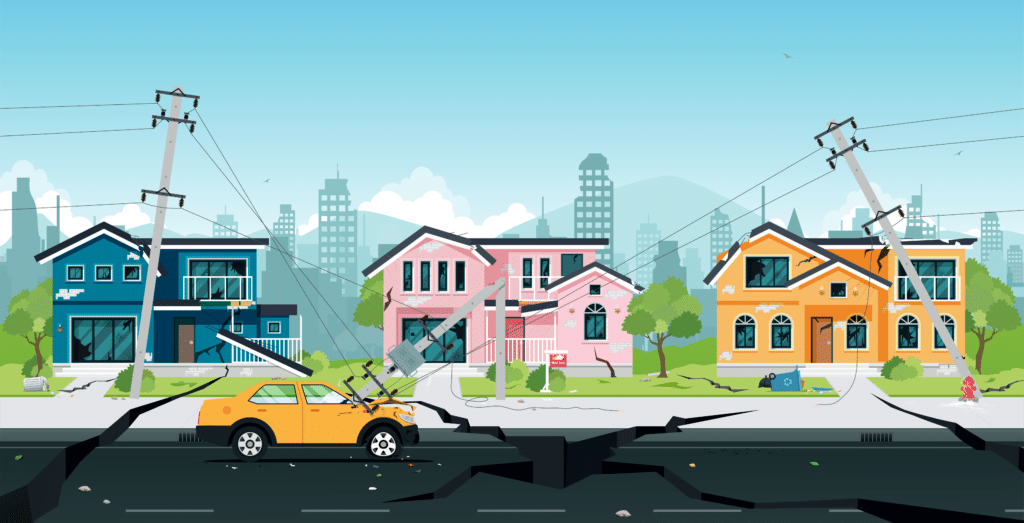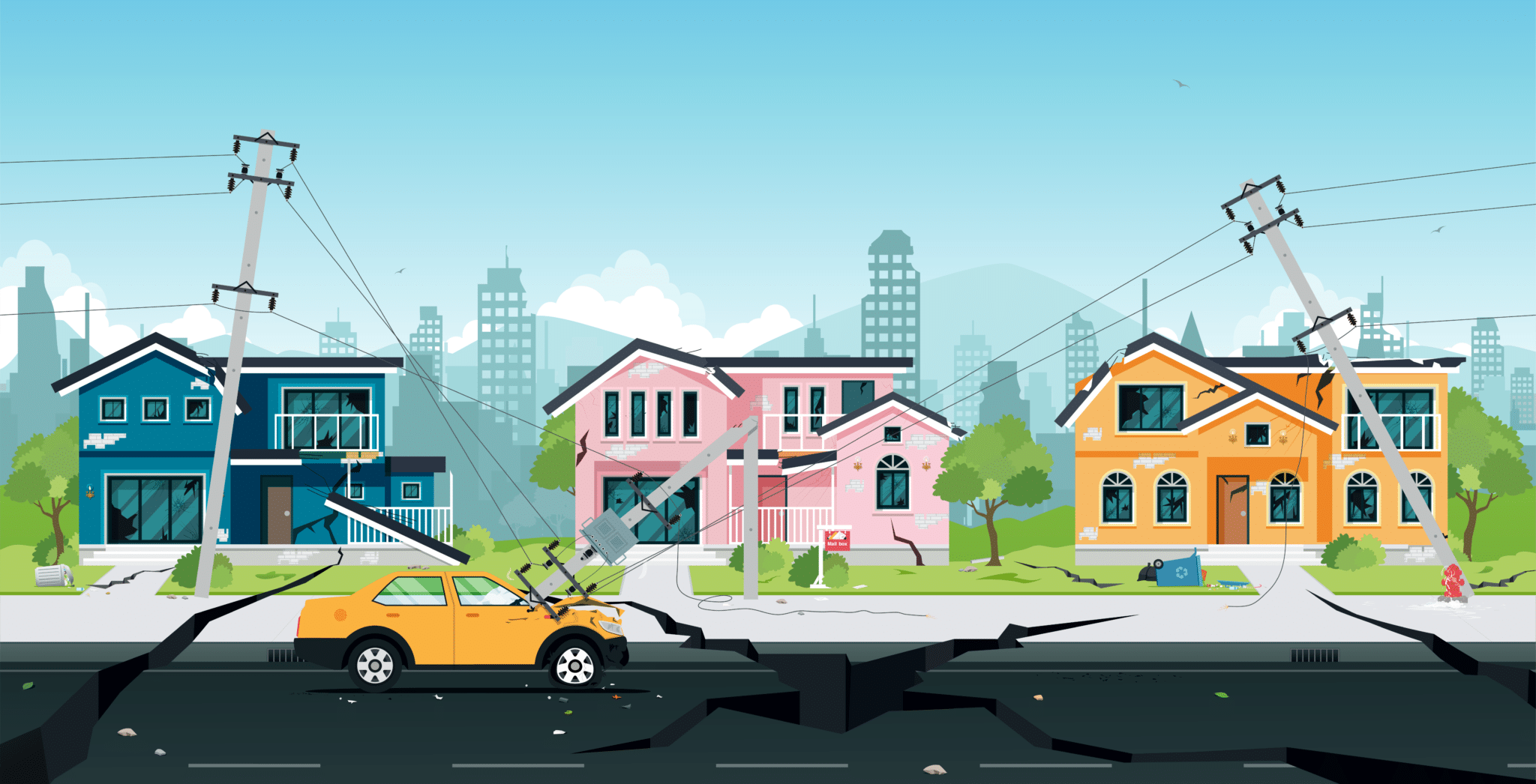How to Prepare Your Home for an Earthquake
Although some locations are more at risk for earthquakes, no region is fully exempt from natural disasters. It’s important to prepare your home in advance so that plans and arrangements are in place if an earthquake does occur, alleviating you some stress later on.

Read on for tips on how to prepare your home for an earthquake!
Make a Plan
You want to be prepared for an earthquake, so having a plan in place well before the event is advisable. Ensure that you are familiar with your local community’s disaster preparedness, evacuation routes, and emergency services. Plan where you can meet with family and friends should you become separated from them, and how to keep in touch with each other—especially if cell service is compromised.
Know the Risks
Give yourself advance of any problematic situations by signing up for hazard notifications. You can reference the hazard map from the United States Geological Survey and sign up for bi-monthly earthquake updates and tips from FEMA by texting “EARTHQUAKE” to 43362. Learn what you can about your area’s seismic building standards and land use codes for more information.
Compile an Emergency Supply Kit
Keeping an emergency kit handy is an excellent way to ensure that you are prepared for any unexpected situation. In addition to basic essentials and first aid products, ensure that your kit includes tools for shutting off gas and water mains, water purification tablets, packaged snacks, and space blankets. Having a road map is also helpful, just in case you cannot access the internet or online GPS services.
Run Drills
Especially for people who live in highly susceptible areas to earthquakes, it’s a good idea to conduct periodic earthquake drills to help your family prepare for the worst. That way, if you are experiencing an earthquake, you are ready to go and used to the routine—removing one source of stress.
Designate Space
It’s a good idea to select a space to keep necessities in your home. For example, use a cupboard or closet to keep some essentials in, in the event you cannot leave the house to get food, water, or other necessities during an earthquake. The following are some of the items you should keep on hand:
- 3-day supply of non-perishable and packaged food items that can be prepared without access to electricity or gas
- 3-day supply of water
- Radio powered by hand-crank or reusable energy sources
- Camp stove or generator
- Crescent wrench
- Fire extinguisher
- Flashlight and extra batteries
- Jackets and durable shoes for everyone
- Pet or baby supplies, if necessary
- Waterproof matches
Identify Safe Spots
Identify safe spots in every room of the house. Sturdy furniture and interior walls are good places to shelter. Keep away from windows, unsecured furniture, and heavy hanging objects because they are potentially dangerous places during an earthquake. Shelter in a safe place until all tremors have ceased.
Secure Major Appliances
Make sure that your major appliances will not move during an earthquake. Ensure your appliances are secure by bolting them down or reinforcing the bases. For example, strapping your water heater to the wall ensures that it will remain upright and prevent pipes from rupturing. Remove the wheels or roller equipment from larger appliances to avoid them moving around during an earthquake and causing damage to you or your house. Flexible nylon straps and buckles are great for securing objects, such as TVs, microwaves, and stereos, to prevent them from falling and damaging you or your home.
Move Heavy Objects
Place heavy and oversized objects on low-level shelves and avoid keeping large items on upper shelves. A primary cause of earthquake-related injuries is falling objects, so making sure any heavy pictures and mirrors are secured to the wall with wire and eye screws is essential. For extra precaution, do not position these items above couches, chairs, or beds in case they fall.
Fasten Small Items in Place
Secure your smaller items and valuables by installing lip guards on shelving or using Velcro adhesives to keep them in place. Removable putty can keep delicate and breakable items safely in place. Alternatively, you can store small items in low cabinets or filing cabinets.
Secure Furnishings
Tall furniture items, such as bookcases and shelving units, should be fastened to the wall to prevent them from falling over during an earthquake. In addition, make sure that overhead light fixtures are secured safely to the ceiling, and any breakable objects are stored in low, closed cabinets equipped with latches. You can help keep furnishings upright by securing items with nylon straps and buckles to wall studs.
Install Latches
Prevent your things from falling out of the cupboards where they are kept by attaching latches to the doors. Kitchen and bathroom cabinets can open during an earthquake, spilling items everywhere and making cleanup worse, so keep them latched to avoid this!
Apply Safety Film
Protect your windows and doors’ glass from breaking by applying clear, safety film. This is also important for homes with hanging plants or decorations that could swing into the glass during an earthquake damaging windows or doors. Ensure your windows and doors are protected with clear, shatterproof film is essential and relatively inexpensive.
Position the Beds
You don’t want to risk earthquake damage, especially while you are sleeping! So place all beds away from windows and against interior walls to prevent damage caused by window breakage and provide more stability.
Remove Flammable Liquids
To prevent the risk of fire, move any flammable liquids from your home’s living areas and store them outside or in the garage. Keep them away from any heat sources such as water heaters or furnaces.
Know About Your Utilities
Ensure that you know where all the water, gas, and electrical shut-offs are in your home and that everyone knows how to turn it off. In the event of an earthquake, you should turn off all utilities at the main sources to prevent leaks or further damage. Additionally, you can hire a plumber to install flexible connectors on your gas appliances, including the stove, water heater, washer, and dryer, that will allow for some movement during an earthquake and avoid rupturing.
Plan Your Backyard
Consider the safety of your yard when it comes to earthquakes. If you have slopes or a hillside in the backyard, you can consider installing a retaining wall for better stability and avoid the risk of landslides. Alternatively, you can install artificial grass in your yard to help manage erosion and runoff that lead to landslides during an earthquake.
Consider Your Trees
Prune away the tree limbs adjacent to your home to avoid any damage caused by falling branches. If you have a weak tree in the yard, you might want to consider removing it to reduce the risk of damage from it falling over or becoming uprooted during an earthquake. Trees with extensive damage to the roots or trunk can be hazardous in a seismic situation.
Use Earthquake-Friendly Materials
Because concrete is very likely to crack during an earthquake, making it difficult to gain access to your yard or vehicle, replacing your outdoor surfaces with more resilient options is a good idea. Paving stones offer better weight distribution than concrete slabs and are more flexible in tremor situations. Avoid expensive repairs and further outdoor obstacles by investing in earthquake-friendly materials for your property!
Brace for Impact
If your house is built on a raised foundation, ensure it has shear plywood walls in any crawlspaces. Some older homes may have cripple walls instead, a short wood-stud wall situated between the top of the foundation wall and the first floor. If this is the case, you can apply sheathing to stabilize the foundation further.
Check the Foundation
Ensure that you check the house foundation and walls for any cracks and defects that can make your home more vulnerable to damage in an earthquake. Then, hire a professional contractor to make any repairs necessary. A professional engineer can also evaluate the building and suggest strengthening tips for exterior areas like decks, garages, and patios. You can also add anchor bolts or steel plates to the foundation to make it sturdier.
Don’t Forget About the Chimney
Brace any unreinforced chimneys or masonry. For example, you can secure chimneys to the roof with sheet metal straps and add an angle brace to avoid the risk of having your chimney break away from your house during an earthquake.
Please be aware that most homeowners insurance policies will not cover earthquakes. To ensure you get the proper coverage, reach out to your Insureberry agent for more information.





There are no comments